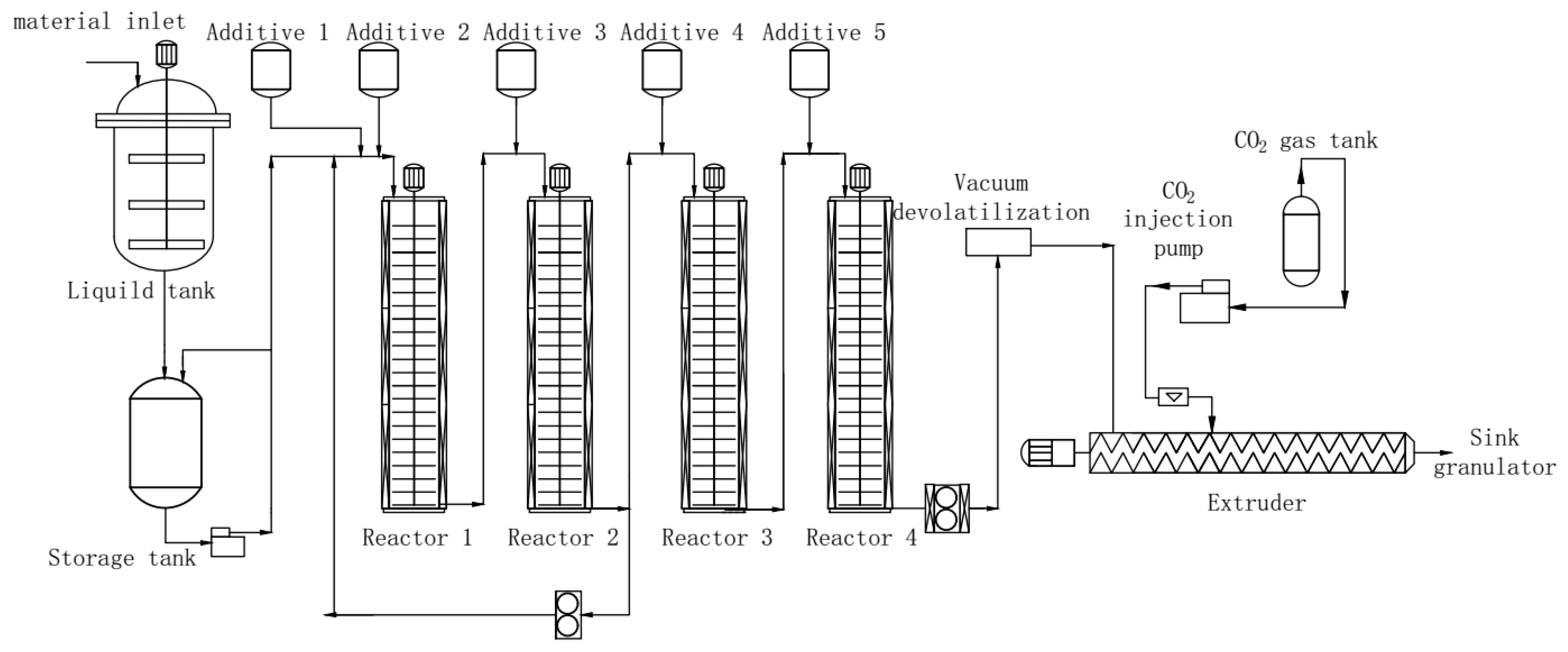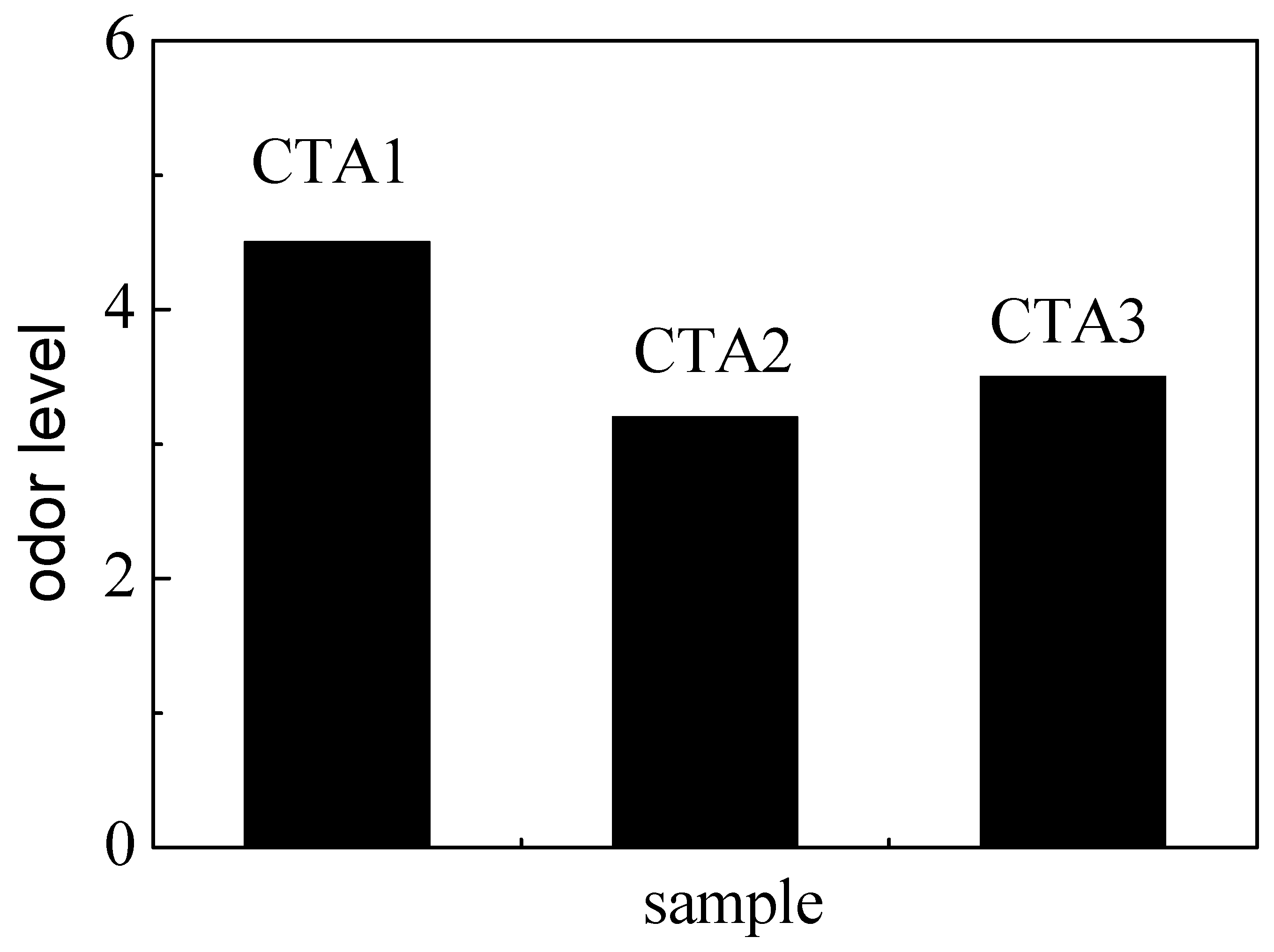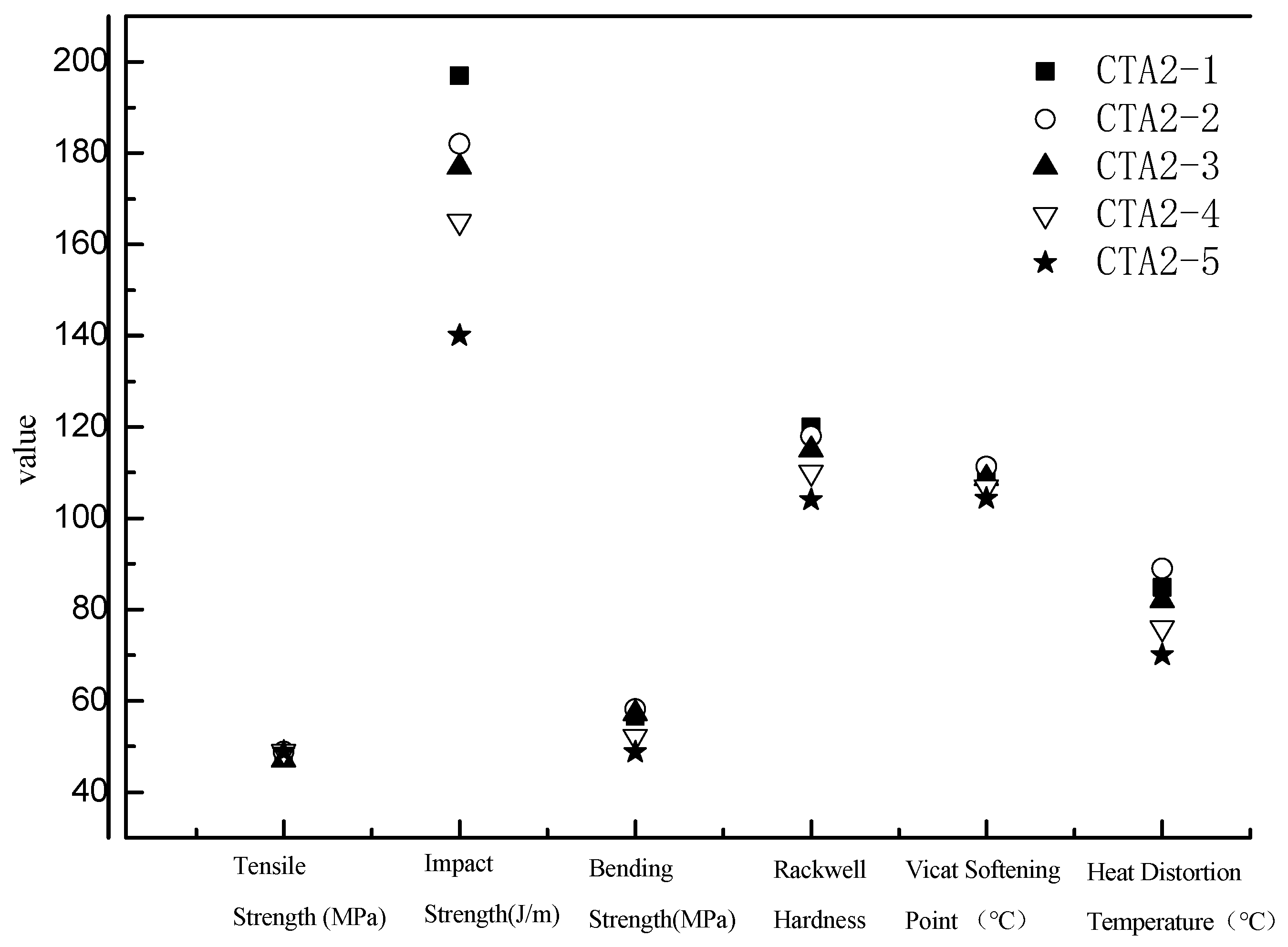Synthesis of Environmentally Friendly Acrylonitrile Butadiene Styrene Resin with Low VOC
Abstract
:1. Introduction
2. Materials and Methods
2.1. Synthesis
2.2. Characterization
3. Results and Discussions
3.1. Effect of Chain Transfer Agents on VOC Content of ABS Resin
3.1.1. Influence of Chain Transfer Agents on the Thermal Stability of ABS Resin
3.1.2. Influence of Different Chain Transfer Agents on Mechanical Properties and Odor Levels of ABS Resins
3.1.3. The Effect of Chain Transfer Agent Content
3.2. Supercritical Extraction of VOC from ABS Resins
4. Conclusions
Author Contributions
Funding
Conflicts of Interest
References
- Jansen, D.; Neubauer, J.; Goetz-Neunhoeffer, F.; Haerzschel, R.; Hergeth, W.D. Change in reaction kinetics of a Portland cement caused by a superplasticizer—Calculation of heat flow curves from XRD data. Cement Concr. Res. 2012, 42, 327–332. [Google Scholar] [CrossRef]
- Gümperlein, I.; Fischer, E.; Dietrich-Gümperlein, G.; Karrasch, S.; Nowak, D.; Jörres, R.A.; Schierl, R. Acute health effects of desktop 3D printing (fused deposition modeling) using acrylonitrile butadiene styrene and polylactic acid materials: An experimental exposure study in human volunteers. Indoor Air 2018, 28, 611–623. [Google Scholar] [CrossRef]
- Villberg, K.; Veijanen, A.; Gustafsson, I.; Wickström, K. Analysis of odour and taste problems in high-density polyethene. J. Chromatogr. A 1997, 791, 213–219. [Google Scholar] [CrossRef]
- Reingruber, E.; Reussner, J.; Sauer, C.; Standler, A.; Buchberger, W. Studies on the emission behavior of polypropylene by gas chromatography/mass spectrometry with static headspace or thermodesorption. J. Chromatogr. A 2011, 1218, 3326–3331. [Google Scholar] [CrossRef] [PubMed]
- Wrona, M.; Vera, P.; Pezo, D.; Nerín, C. Identification and quantification of odours from oxobiodegradable polyethylene oxidised under a free radical flow by headspace solid-phase microextraction followed by gas chromatography-olfactometry-mass spectrometry. Talanta 2017, 172, 37–44. [Google Scholar] [CrossRef] [PubMed]
- Hodgson, S.C.; Casey, R.J.; Bigger, S.W.; Scheirs, J. Review of volatile organic compounds derived from polyethylene. Polym. Plast. Technol. Eng. 2000, 39, 845–874. [Google Scholar] [CrossRef]
- Hopfer, H.; Haar, N.; Stockreiter, W.; Sauer, C.; Leitner, E. Combining different analytical approaches to identify odor formation mechanisms in polyethylene and polypropylene. Anal. Bioanal. Chem. 2012, 402, 903–919. [Google Scholar] [CrossRef] [PubMed]
- Riise, B.L.; Rau, R.C.; Biddle, M.B. Methods for Reducing Contamination in Plastics Recovered from Durable Goods. U.S. Patent 20,130,032,167 A1, 7 February 2013. [Google Scholar]
- Miyakawa, H.; Shinohara, T.; Maeda, T. Method for Purifying Polymer. U.S. Patent 5,237,048, 17 August 1993. [Google Scholar]
- Krupinski, S.M.; McQueen, J.T. Devolatilization. U.S. Patent 5,691,445, 25 November 1997. [Google Scholar]
- Odell, P.G. Polycarbonate Processes with Supercritical Carbon Dioxide. U.S. Patent 5,698,665, 16 December 1997. [Google Scholar]
- Meyer, W.; Bohan, J.L.; Timberlake, L.D.; Siebecker, J.D. Process for Controlling the Molecular Weight of Polymers of Bromostyrene. U.S. patent 20,100,120,990, 13 May 2010. [Google Scholar]
- Placek, C. ABS Resin Manufacture; Noyes Publications: Norwich, NY, USA, 1970. [Google Scholar]
- Liu, J.; Wang, Y.; Fu, Q.; Zhu, X.; Shi, W. Branched polymer via free radical polymerization of chain transfer monomer: A theoretical and experimental investigation. J. Polym. Sci. A Pol. Chem. 2008, 46, 1449–1459. [Google Scholar] [CrossRef]
- Jang, B.N.; Wilkie, C.A. A TGA/FTIR and mass spectral study on the thermal degradation of bisphenol A polycarbonate. Polym. Degrad. Stab. 2004, 86, 419–430. [Google Scholar] [CrossRef] [Green Version]
- Deng, Y.; Zhang, Z.; Li, X.; Yang, Y. The effects of APP, APP/MMT nanocomposites on the thermal degradation of ABS resin. J. Appl. Polym. Sci. 2014, 131, 40704. [Google Scholar] [CrossRef]







| Name | CTA2 | CTA3 | CTA1 |
|---|---|---|---|
| Molecular formula | C9H10 | C4H8O2S | C12H26S |
| Molecular weight | 118.18 | 120.17 | 202.40 |
| Exterior | Light yellow viscous liquid | Colorless-very light yellow transparent liquid | Colorless or light yellow liquid |
| Level | Parameters | |||
|---|---|---|---|---|
| A | B | C | D | |
| Temperature, °C | Residence Time, min | Vacuum Degree (C), MPa | CO2 Content, % | |
| 1 | 240 | 1 | −0.095 | 1 |
| 2 | 245 | 1.2 | −0.097 | 1.5 |
| 3 | 250 | 1.5 | −0.099 | 1.8 |
| Test Number | Setup Conditions | Result | |||
|---|---|---|---|---|---|
| Temperature | Residence Time | Vacuum Degree | CO2 Content | TVOC Content (ppm) | |
| 1 | 240 | 1 | −0.095 | 1 | 49.325 |
| 2 | 240 | 1.2 | −0.097 | 1.5 | 36.697 |
| 3 | 240 | 1.5 | −0.099 | 1.8 | 47.641 |
| 4 | 245 | 1 | −0.097 | 1.8 | 44.714 |
| 5 | 245 | 1.2 | −0.099 | 1 | 29.092 |
| 6 | 245 | 1.5 | −0.095 | 1.5 | 38.168 |
| 7 | 250 | 1 | −0.099 | 1.5 | 25.317 |
| 8 | 250 | 1.2 | −0.095 | 1.8 | 59.356 |
| 9 | 250 | 1.5 | −0.097 | 1 | 52.958 |
| Parameters | |||||
|---|---|---|---|---|---|
| A | B | C | D | ||
| Parameter | Temperature | Residence Time | Vacuum Degree | Extractant | Experimental Result |
| 1 | 1 | 1 | 1 | 1 | 49.325 |
| 2 | 1 | 2 | 2 | 2 | 36.697 |
| 3 | 1 | 3 | 3 | 3 | 47.641 |
| 4 | 2 | 1 | 2 | 3 | 44.714 |
| 5 | 2 | 2 | 3 | 1 | 29.092 |
| 6 | 2 | 3 | 1 | 2 | 38.168 |
| 7 | 3 | 1 | 3 | 2 | 25.317 |
| 8 | 3 | 2 | 1 | 3 | 59.356 |
| 9 | 3 | 3 | 2 | 1 | 52.958 |
| Mean 1 | 44.554 | 39.785 | 48.950 | 43.792 | |
| Mean 2 | 37.325 | 41.715 | 44.790 | 33.394 | |
| Mean 3 | 45.877 | 46.256 | 34.017 | 50.570 | |
| Range | 8.552 | 6.471 | 14.933 | 17.176 | |
| Parameter | Sum of Squared Deviation | Degree of Freedom | Variance | F | P |
|---|---|---|---|---|---|
| Temperature A | 127.160 | 2 | 63.580 | 1.921 | <0.01 |
| Residence time B | 66.206 | 2 | 33.103 | 0.999 | <0.01 |
| Vacuum C | 356.358 | 2 | 178.179 | 5.382 | <0.01 |
| Extractant D | 449.088 | 2 | 224.544 | 6.783 | <0.01 |
| error | 66.21 | 2 | 33.105 |
© 2020 by the authors. Licensee MDPI, Basel, Switzerland. This article is an open access article distributed under the terms and conditions of the Creative Commons Attribution (CC BY) license (http://creativecommons.org/licenses/by/4.0/).
Share and Cite
Fan, L.; Wei, L.; Zhu, Y.; Wang, Y.; Fei, J.; Li, Y. Synthesis of Environmentally Friendly Acrylonitrile Butadiene Styrene Resin with Low VOC. Materials 2020, 13, 1663. https://doi.org/10.3390/ma13071663
Fan L, Wei L, Zhu Y, Wang Y, Fei J, Li Y. Synthesis of Environmentally Friendly Acrylonitrile Butadiene Styrene Resin with Low VOC. Materials. 2020; 13(7):1663. https://doi.org/10.3390/ma13071663
Chicago/Turabian StyleFan, Licheng, Lijuan Wei, Yongfei Zhu, Yibo Wang, Jianmin Fei, and Yang Li. 2020. "Synthesis of Environmentally Friendly Acrylonitrile Butadiene Styrene Resin with Low VOC" Materials 13, no. 7: 1663. https://doi.org/10.3390/ma13071663




